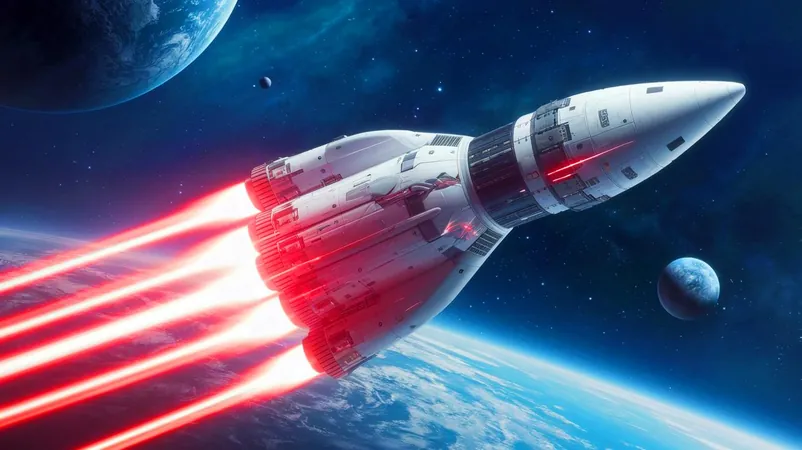
Pioneering Fusion Rockets Set to Transform Space Travel: A Leap Towards Interplanetary Exploration
2025-04-05
Author: Olivia
The Future of Efficient Space Travel
Fusion propulsion represents a monumental step forward in the evolution of space travel. Unlike traditional chemical rockets that rely on combustion reactions, fusion rockets emulate the process that powers our Sun—fusing hydrogen isotopes to produce immense energy. This transformation results in an efficient propulsion system capable of achieving speeds that were once thought impossible, potentially slashing interplanetary travel times by half.
Imagine a future where journeys to Mars take weeks instead of months! With a virtually limitless energy source from fusion, long-distance space missions could become a reality, opening up avenues for exploration and colonization not just within our solar system but far beyond.
Meet the Sunbird: The Game-Changer in Space Engineering
The Sunbird is not just any rocket; it's an innovative approach to space travel. Designed to operate as a 'tugboat' for interplanetary cargo, the Sunbird will be stored in orbital satellite docks, ready to embark on missions. This method could significantly cut costs associated with launching from Earth, making it a game-changer for various missions, from scientific exploration to potential colonization projects.
At the heart of the Sunbird is its Duel Direct Fusion Drive (DDFD) engine, which promises to significantly enhance propulsion capabilities. With static testing planned for this year and an in-orbit demonstration set for 2027, Pulsar Fusion's rapid development timeline is fueled by over a decade of painstaking research and innovation, shrouded in secrecy until now.
Overcoming Engineering Hurdles
While the prospect of harnessing fusion for space travel is exhilarating, it is important to recognize the multitude of engineering challenges that lay ahead. Achieving the required conditions for sustained fusion reactions demands precision and advanced technology. However, the Sunbird has a distinct advantage by utilizing a deuterium-helium-3 fuel source, which allows for powerful bursts of thrust without necessitating continuous operation. This approach mitigates several engineering hurdles while leveraging the exceptional performance standards associated with fusion energy.
Advanced cooling systems must also be developed to handle the immense heat generated during the fusion process. As Pulsar Fusion and other players in the industry continue to confront these challenges, the potential benefits underscore the viability of fusion propulsion technology, illustrating that we are on the brink of a transformative era in space exploration.
A New Chapter in Human Endeavour
The advent of fusion-powered rockets heralds a transformative period in human space exploration. As organizations like NASA and DARPA pursue their nuclear propulsion initiatives, the prospect of reaching distant worlds becomes increasingly tangible. Missions to Mars, and even further into the cosmos, could soon transition from dreams to plans, vastly expanding our understanding of the universe and our capacity for exploration.
Despite the historical skepticism surrounding nuclear propulsion development, the advances made by Pulsar Fusion and similar firms bring a glimmer of hope that this new technology will fulfill its promises. As we venture forth, a crucial question remains: How will humanity leverage the power of fusion to unlock the mysteries of the universe and secure a sustainable future beyond Earth?
The rapid strides in fusion propulsion technology not only reshape our approach to space travel but prepare us for a future where interplanetary journeys could become as routine as air travel today. With groundbreaking designs like the Sunbird at the forefront, the dream of traversing the cosmos is closer now than ever before. What remarkable discoveries and advancements lie just over the horizon for humankind as we push the boundaries of what is possible in space exploration? The adventure has only just begun!









 Brasil (PT)
Brasil (PT)
 Canada (EN)
Canada (EN)
 Chile (ES)
Chile (ES)
 Česko (CS)
Česko (CS)
 대한민국 (KO)
대한민국 (KO)
 España (ES)
España (ES)
 France (FR)
France (FR)
 Hong Kong (EN)
Hong Kong (EN)
 Italia (IT)
Italia (IT)
 日本 (JA)
日本 (JA)
 Magyarország (HU)
Magyarország (HU)
 Norge (NO)
Norge (NO)
 Polska (PL)
Polska (PL)
 Schweiz (DE)
Schweiz (DE)
 Singapore (EN)
Singapore (EN)
 Sverige (SV)
Sverige (SV)
 Suomi (FI)
Suomi (FI)
 Türkiye (TR)
Türkiye (TR)
 الإمارات العربية المتحدة (AR)
الإمارات العربية المتحدة (AR)